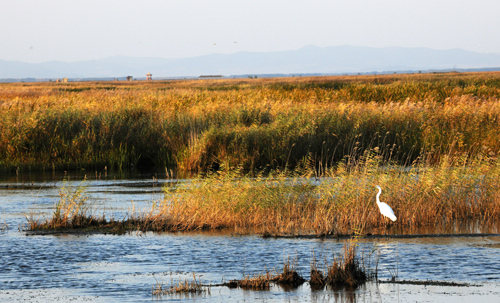|
 |
|
FERTILE LAND: The Qixing River Wetland in Heilongjiang Province was recently named a wetland of international importance at the Sixth Asian Wetland Symposium held in Wuxi City, east China's Jiangsu Province, on October 13 (HAO YUANZHENG) |
Watching flocks of waterfowl taking off and landing in the large expanse of wetland near his home is a favorite pastime of Li Qiwen, a middle-aged primary school teacher in Weichang Township, Luobei County in Heilongjiang Province.
The wetland is home to hundreds of species of birds, including rare white storks and red-crowned cranes, as well as more common geese and ducks.
The picturesque wetland near Li's hometown comprises a large part of the Sanjiang Plain, a low-lying plain strewn with marshes. The plain is one of China's major wetland regions.
Wetlands have been found to play a role in mitigating climate change. Researches show that wetlands all over the world sequestrate as much as one third of global carbon emissions.
At the Sixth Asian Wetland Symposium held in Wuxi City, east China's Jiangsu Province, on October 13, participants adopted of the Wuxi Declaration, in which they called for intensified efforts to ensure the conservation and wise use of wetlands.
At the symposium's opening ceremony, Anada Tiega, Secretary General of the Ramsar Convention, announced that four more wetlands in China had been classified as wetlands of international importance, bringing the total number of Chinese wetlands on the Ramsar list to 41.
The Ramsar Convention, an international treaty on wetland conservation and sustainable utilization, signed in February 1971 in Ramsar, Iran, went into force in 1975. China ratified the convention in 1992.
Three of the four wetlands, the Zhenbao Island, the Qixing River and the Nanweng River are in Heilongjiang Province. Now, with seven wetlands of international importance, Heilongjiang is the Chinese province with the most wetlands of international importance.
"China has a total of 38.48 million hectares of wetlands, the largest area in Asia," said Yan Chenggao, Director of Wetland Management Center of the State Forestry Administration. Wetlands account for 3.77 percent of China's total landmass.
Since the 1950s the demand for land from a large population, rapid economic growth and a lack of understanding regarding the profound ecological value of wetlands led to extensive and irrational reclamation. More than 50 percent of China's wetlands were destroyed between 1950 and 2000.
Recently, as the importance of wetlands has been better understood, the Chinese Government has taken major initiatives to conserve wetlands and some previously reclaimed wetlands have been restored.
Official statistics show that China restores more than 10,000 hectares of wetlands each year and 50.3 percent of all the country's wetlands are currently under protection.
Lying in the northernmost part of China with long and harsh winters, the Sanjiang Plain used to be an almost uninhabited wilderness. The wetland's black soil, however, is fertile. In the first half of the 20th century, many people migrated to the region and converted local wetlands into farms. The plain became one of China's major suppliers of corn, soybeans and rice.
Before large scale reclamation in the 1950s, wetlands accounted for more than 80 percent of the Sanjiang Plain, but today the area of wetlands had shrunk by 80 percent, said Liu Xingtu, a researcher with the Northeast Institute of Geography and Agroecology of the Chinese Academy of Sciences.
Liu said that from 1949 till the 1990s, the Sanjiang Plain has experienced four rounds of land reclamation. In the mid-1990s, the reclamation frenzy also swept the Weichang Wetland near Li's hometown. Bulldozers, tractors and excavators trundled through the area, turning 80 percent of the wetland into arable fields. The Weichang Economic Development Zone was set up and dozens of buildings grew out of what had once been a pristine ecosystem.
"When migrating birds came back in the spring, they could not find their homes. They hovered in the sky, but could not find a place to settle down. Then they left the wetland," Li said.
Li was very upset by the destruction he saw and repeatedly wrote to the local government, petitioning officials to stop the exploitation and protect wetlands. He also did his best to impart the importance of wetlands to villagers.
Fortunately, after ratifying the Ramsar Convention in 1992, the Chinese Government gradually scaled up wetland protection and restoration.
| 